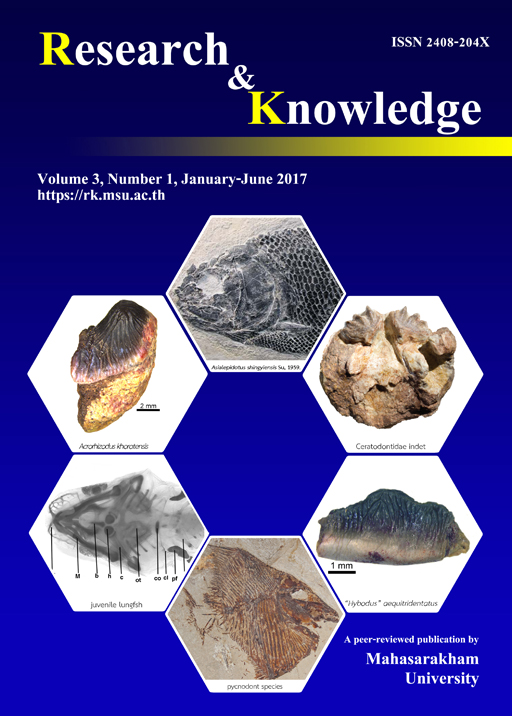Possible sexual dimorphism in Pankowskichthys libanicus (Neopterygii, Pycnodontiformes) from the Cenomanian of Lebanon
Keywords:
Late Cretaceous, Gladiopycnodontidae, Haqel, sexual dimorphismAbstract
Sexual dimorphism is a commonly observed phenomenon in the natural world today but it is far more difficult to determine how common it was in extinct taxa. Here, we describe a new specimen of Pankowskichthys libanicus (Pycnodontiformes, Gladiopycnodontidae) from Haqel, Lebanon (MNHN HAK 1950), which has distinct morphological differences from the holotype of this taxon (IRSNB P9278) which occurs in Hjoula, Lebanon but has also been found at Haqel. Since most of the cranial and pectoral girdle morphologies as well as other postcranial characters are similar to that seen in IRSNB P9278, the distinctive characters seen in MNHN HAK 1950 are unlikely to define a second species but rather represent sexual dimorphic traits.
References
Berra, T. M. and Humphrey, J. D. (2002). Gross anatomy and histology of the hook and skin of forehead brooding male nurseryfish, Kurtus gulliveri, from northern Australia. Environmental Biology of Fishes 65, 263- 270.
Borkovic, B. 2013. Investigating Sexual Dimorphism in Ceratopsid Horncores. Ph.D. dissertation, Department of Biological Sciences, University of Calgary, Canada.
Britz, R., Conway, K.W. and Rüber, L. 2009. Spectacular morphological novelty in a miniature cyprinid fish, Danionella dracula n. sp. Proceedings of the Royal Society of London, Series B Biological Sciences 276, 2179-2186.
Capasso, L.L., Abi Saad, P. and Taverne, L. 2009. Nursallia tethysensis sp. nov., a new pycnodont fish (Neopterygii:† Halecostomi) from the Cenomanian of Lebanon. Bulletin de l’Institut Royal des Sciences Naturelles de Belgique. Sciences de la Terre 79, 117-136.
Capasso, L.L., Taverne, L. and Nohra, A.R. 2010. A re-description of Hensodon spinosus, a remarkable coccodontid fish (Actinopterygii,† Pycnodontiformes) from the Cenomanian (Late Cretaceous) of Haqel, Lebanon. Bulletin de l’Institut Royal des Sciences Naturelles de Belgique, Sciences de la Terre
Gayet M., Abi Saad P. and Gaudant O. 2012. Les fossiles du Liban. Mémoire du temps. Éditions Désiris, Méolan-Revel, pp. 184.
Horner, J. and Goodwin, M. 2006. Major cranial changes during Triceratops ontogeny. Proceedings of the Royal Society B 273, 2757-2761.
Marráma, G., Villier, B., Dalla Vecchia, F.M. and Carnev - ale, G. 2016. A new species of Gladiopycnodus (Coccodontoidea, Pycnodontomorpha) from the Cretaceous of Lebanon provides new insights about the morphological diversification of pycnodont fishes through time. Cretaceous Research 61, 34-43.
Muñoz, R.C., Zgliczynski, B.J., Laughlin, J.L. and Teer, B.Z. 2012. Extraordinary aggressive behavior from the giant coral reef fish, Bolbometopon muricatum, in a remote marine reserve. PloS one 7, e38120.
Ostrom, J. and Wellnhofer, P. 1990. Triceratops: an exam - ple of flawed systematics. In: Carpenter, K. and P. Currie, P. (Eds.), Dinosaur Systematics: Perspectives and Approaches. Cambridge University Press. Cam - bridge, UK, pp. 245-254.
Scannella, J. and Fowler, D. 2009. Anagenesis in Tricera - tops: evidence from a newly resolved stratigraphic framework for the Hell Creek Formation. Cincinnati Museum Center Scientific Contributions 3, 148-149.
Schuck, H. A. 1951. Notes on the dolphin (Coryphaena hippurus) in North Carolina waters. Copeia 1951, 35-39.
Taverne, L. and Capasso, L. 2014. On the “Coccodus” lindstroemi species complex (Pycnodontiformes, Gladiopycnodontidae) from the marine Late Creta - ceous of Lebanon, with the description of two new genera. European Journal of Taxonomy 101, 1-27.
Downloads
Published
How to Cite
Issue
Section
License

This work is licensed under a Creative Commons Attribution-NoDerivatives 4.0 International License.








